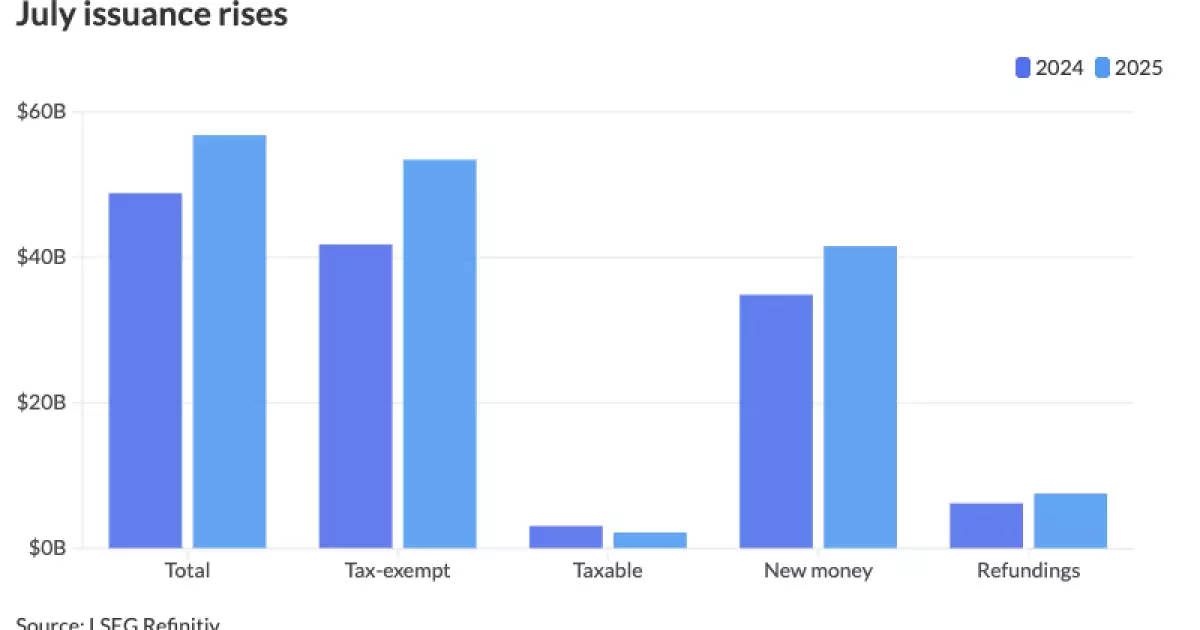The first half of 2025 has shattered previous records in municipal bond issuance, revealing a market that appears robust and resilient—yet beneath the surface, ominous signs of overextension and vulnerability lurk. The astonishing surge, with issuance soaring to over $280 billion—up 14.3% from last year—may seem like a testament to investor confidence, but it also reveals a tactical race among issuers to secure affordable financing amid mounting political and economic uncertainties. This relentless pace suggests a desperation to lock in capital before potential policy changes or market shocks threaten these favorable conditions. While such frontloading might temporarily sustain growth and support vital public projects, it raises questions about the true health of the sector in the long term.
The pattern of heightened weekly issuance, some weeks topping $20 billion, illustrates a collective strategy of “peak borrowing” designed to mitigate risk from possible federal regulatory upheavals, especially around tax exemptions and policy reforms that could diminish future value. This tendency is not merely opportunistic but symptomatic of a broader uncertainty among issuers—particularly educational institutions and private activity bonds—who are choosing to accelerate their fundraising efforts rather than wait for a more stable environment. The fact that these issuers are rushing to market may portend a bubble that is being artificially inflated, with the actual underlying fiscal health potentially less rosy than market figures suggest.
Market Dynamics and the Imperial Shield of Investor Resilience
In such a volatile environment, one might assume retail investors—historically the backbone of municipal bonds—would retreat or become more cautious. Paradoxically, the data indicates the opposite. Diamond’s observation that the retail segment “was not looking for exits” during turbulent April, even amid tariff-induced volatility, is a sign that investor confidence remains surprisingly persistent. This persistent appetite could be attributed to the current environment of higher interest rates, offering a substantial “cushion” of 30 to 40 basis points in monthly income. Such income provides some comfort to investors, acting as an unspoken insurance policy against future downturns.
However, this apparent resilience might also mask underlying risks. When the same investor base continues to pour money into a rapidly expanding bond market, it suggests a collective hubris that assumes the current environment of growth and stability will persist indefinitely. Yet with rates expected to plateau or even decline, and political pressures mounting around the tax exemption—an essential feature of municipal bonds—the foundations of this confidence risk being shaken.
The market’s reflexive behavior—triggered by favorable conditions and an urgent desire to capture deals—may well be an unhealthy addiction to liquidity and low yields. The fact that issuers are betting on the future stability of these conditions, often pricing deals as soon as conditions seem “marketable,” reflects a herd mentality that could lead to overleveraging. If interest rates fall or if federal policy shifts unexpectedly, the current exuberance could turn to mass sell-offs, exploding the bubble once market sentiment overturns.
The Political Underpinning: Finalizing the Endgame of Tax Benefits
Politically, 2025 could have been a year of significant upheaval for municipal financing—yet, surprisingly, the most feared threat—the repeal of the tax exemption—has been narrowly avoided so far. The initial gloom surrounding potential reductions or targeted cuts to private-activity bonds and other tax-advantaged structures appears to have softened, thanks to legislative compromises. While such exemptions remain technically intact, the possibility of future restrictions is far from eliminated. Political winds continue to favor targeted reforms, especially for specialized sectors like airports, hospitals, and universities that heavily rely on these tax benefits.
This creates a fragile environment where issuers, especially elite universities that have gone to market amid federal funding cuts, may be betting on continued stability of these incentives. But this is a gamble rooted in political optimism rather than economic sustainability. Ironically, the focus shifts from safeguarding broad fiscal responsibility to securing short-term access to low-cost capital for specific sectors, risking a misalignment between debt levels and public capacity to repay.
The sheer volume of issuance, now surpassing initial forecasts by a wide margin, raises questions about future fiscal discipline. Will local governments and institutions continue this aggressive borrowing spree, or will mounting debt levels constrain their long-term fiscal flexibility? The unchecked rise of state-issued bonds—California alone accounting for nearly a quarter of the total with $45.58 billion—amplifies concerns about regional disparities and the potential for runaway debt in some areas, risking systemic instability if market perception sours.
The Future of Municipal Bond Markets: Riding a Volatile Wave
The recent trends in July and June issuance highlight the dual nature of this market’s trajectory. On the one hand, the impressive growth—driven by strategic frontloading and investor confidence—suggests a buoyant market ready to push boundaries. On the other, the same volatility that characterized the entire year underscores how fragile this growth might be. The market is increasingly driven by tactical decisions—issuers rushing to lock in deals—rather than foundational fiscal health.
Major players like JPMorgan and Bank of America have revised their issuance estimates upward, reflecting their confidence in the ongoing demand. Yet, this confidence might be misplaced if broader economic conditions deteriorate or if political risks—such as potential tax reforms—materialize. With so much reliance on continued investor appetite, especially from retail buyers who remain willing even during minor downturns, the market is tightly tethered to investor sentiment and the political landscape.
As the market marches toward an anticipated issuance of $560 billion or higher, the question remains: How sustainable is this growth? History suggests that markets driven by frontloading and speculative behavior tend to slow dramatically once the tide turns. At this juncture, the question isn’t whether the market will encounter turbulence but when—and whether policymakers and issuers are truly prepared to face the eventual correction rather than perpetuate a risky expansion under the guise of healthy development.
—
*Note: This analysis reflects a centrist-liberal perspective that recognizes the importance of municipal bonds for infrastructure and social stability while remaining critically aware of the risks posed by overleveraging, political interference, and market excesses.*

